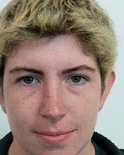
J. Chase Kew
Chase works on machine learning and robotics at Google Brain.
Research Areas
Authored Publications
Google Publications
Other Publications
Sort By
Joint Attention for Multi-Agent Coordination and Social Learning
Dennis Lee
Jiaxing Wu
ICRA Workshop on Social Intelligence in Humans and Robots (2021)
Preview abstract
Joint attention — the ability to purposefully coordinate your attention with another person, and mutually attend to the same thing — is an important milestone in human cognitive development. In this paper, we ask whether joint attention can be useful as a mechanism for improving multi-agent coordination and social learning. We first develop deep reinforcement learning (RL) agents with a recurrent visual attention architecture. We then train agents to minimize the difference between the attention weights that they apply to the environment at each timestep, and the attention of other agents. Our results show that this joint attention incentive improves agents’ ability to solve difficult coordination tasks, by helping overcome the problem of exploring the combinatorial multi-agent action space. Joint attention leads to higher performance than a competitive centralized critic baseline across multiple environments. Further, we show that joint attention enhances agents’ ability to learn from experts present in their environment, even when performing single-agent tasks. Taken together, these findings suggest that joint attention may be a useful inductive bias for improving multi-agent learning.
View details
Model-based Reinforcement Learning for Decentralized Multiagent Rendezvous
Rose E. Wang
Dennis Lee
Edward Lee
Brian Andrew Ichter
Conference on Robot Learning (CoRL) (2020)
Preview abstract
Collaboration requires agents to align their goals on the fly. Underlying the human ability to align goals with other agents is their ability to predict the intentions of others and actively update their own plans. We propose hierarchical predictive planning (HPP), a model-based reinforcement learning method for decentralized multiagent rendezvous. Starting with pretrained, single-agent point to point navigation policies and using noisy, high-dimensional sensor inputs like lidar, we first learn via self-supervision motion predictions of all agents on the team. Next, HPP uses the prediction models to propose and evaluate navigation subgoals for completing the rendezvous task without explicit communication among agents. We evaluate HPP in a suite of unseen environments, with increasing complexity and numbers of obstacles. We show that HPP outperforms alternative reinforcement learning, path planning, and heuristic-based baselines on challenging, unseen environments. Experiments in the real world demonstrate successful transfer of the prediction models from sim to real world without any additional fine-tuning. Altogether, HPP removes the need for a centralized operator in multiagent systems by combining model-based RL and inference methods, enabling agents to dynamically align plans.
View details
Long-Range Indoor Navigation with PRM-RL
Anthony Francis
Marek Fiser
Tsang-Wei Lee
IEEE Transactions on Robotics (T-RO) (2020), pp. 19
Neural Collision Clearance Estimator for Batched Motion Planning
Brian Andrew Ichter
Maryam Bandari
Edward Lee
The 14th International Workshop on the Algorithmic Foundations of Robotics (WAFR) (2020)
Preview abstract
We present a neural network collision checking heuristic, ClearanceNet, and a planning algorithm, CN-RRT. ClearanceNet learns to predict separation distance (minimum distance between robot and workspace) with respect to a workspace. CN-RRT then efficiently computes a motion plan by leveraging three key features of ClearanceNet. First, CN-RRT explores the space by expanding multiple nodes at the same time, processing batches of thousands of collision checks. Second, CN-RRT adaptively relaxes its clearance requirements for more difficult problems. Third, to repair errors, CN-RRT shifts its nodes in the direction of ClearanceNet’s gradient and repairs any residual errors with a traditional RRT, thus maintaining theoretical probabilistic completeness guarantees. In configuration spaces with up to 30 degrees of freedom, ClearanceNet achieves 845x speedup over traditional collision detection methods, while CN-RRT accelerates motion planning by up to 42% over a baseline and finds paths up to 36% more efficient. Experiments on an 11 degree of freedom robot in a cluttered environment confirm the
method’s feasibility on real robots.
View details
FollowNet: Robot Navigation by Following Natural Language Directions with Deep Reinforcement Learning
Pararth Shah
Marek Fiser
Dilek Hakkani-Tur
Third Machine Learning in Planning and Control of Robot Motion Workshop at ICRA (2018)
Preview abstract
Abstract— Understanding and following directions provided
by humans can enable robots to navigate effectively in unknown
situations. We present FollowNet, an end-to-end differentiable
neural architecture for learning multi-modal navigation poli-
cies. FollowNet maps natural language instructions as well
as visual and depth inputs to locomotion primitives. Fol-
lowNet processes instructions using an attention mechanism
conditioned on its visual and depth input to focus on the
relevant parts of the command while performing the navigation
task. Deep reinforcement learning (RL) a sparse reward learns
simultaneously the state representation, the attention function,
and control policies. We evaluate our agent on a dataset
of complex natural language directions that guide the agent
through a rich and realistic dataset of simulated homes. We
show that the FollowNet agent learns to execute previously
unseen instructions described with a similar vocabulary, and
successfully navigates along paths not encountered during
training. The agent shows 30% improvement over a baseline
model without the attention mechanism, with 52% success rate
at novel instructions.
View details
No Results Found
